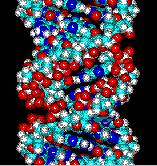DNA Find in Oregon Is Oldest Yet Discovered in Americas
Paisley Caves reveal genetic material in excrement linking New World to Siberia, East Asia.
|
E-mail this article
Subscribe to news
Printer friendly version
|

(SOURCE: University of Oregon, news release, April 3, 2008)
THURSDAY, April 3 (HealthDay News) -- The oldest human DNA ever found in the Americas appears to show genetic links to Siberia or East Asia, according to an international team of scientists.
The mitochondrial DNA (genetic material passed on maternally) was discovered in 14,300-year-old dried human excrement, called coprolites, recovered from the Paisley Caves in Oregon. The series of eight caves are located about 220 miles southeast of Eugene on the eastern side of the Cascade Ranges.
The previous earliest evidence (in the form of tools) of humans in the Americas is the Clovis culture. The Paisley coprolites predate that by about 1,200 years, the scientists said.
Some of the coprolite samples also contained DNA similar to red fox, coyote or wolf. This suggests that these early people ate the animals or that the animals urinated on the human feces.
"The Paisley Cave material represents, to the best of my knowledge, the oldest human DNA obtained from the Americas," Eske Willerslev, director of the Centre for Ancient Genetics at the University of Copenhagen in Denmark, said in a prepared statement.
DNA testing indicated the feces belonged to people in haplogroups A2 and B2, which are common in Siberia and East Asia. It's not known exactly who the people living in the caves were, said Dennis L. Jenkins, a senior archeologist with the University of Oregon's Museum of Natural and Cultural History.
"All we're doing in this paper is identifying the haplogroups. We are not saying that these people were of a particular ethnic group. At this point, we know they most likely came from Siberia or Eastern Asia, and we know something about what they were eating, which is something we can learn from coprolites. We're talking about human signature," Jenkins said in a prepared statement.
"If our DNA evidence and radiocarbon dating hold up on additional coprolites that are now undergoing testing at multiple labs, then we have broken the Clovis sound barrier, if you will," he said. "If you are looking for the first people in North America, you are going to have to step back more than 1,000 years beyond Clovis to find them."
The research was published online April 3 in Science Express.
More information
The U.S. National Library of Medicine has more about DNA.
Copyright © 2008 ScoutNews, LLC. All rights reserved. 
HealthDayNews articles are derived from various sources and do not reflect federal policy. healthfinder.gov does not endorse opinions, products, or services that may appear in news stories. For more information on health topics in the news, visit the healthfinder.gov health library.